使用NUnit进行DotNet程序测试
使用NUnit进行DotNet程序测试
作者:kongxx
介绍
NUnit是目前比较流行的.Net平台的测试工具,以下就简单介绍一下他的开发。
准备
要使用NUnit,首先要确保您的机器上有NUnit的开发包,您可以从http://www.nunit.org/
地方获取并安装(目前版本是NUnit v2.1.91)。正确安装后会在开始菜单下添加一个NUnit 2.2项目。
属性说明
在开始写例子之前,先把NUnit的属性说明一下:
TestFixture (NUnit2.0)
标识当前类是一个包含测试方法的类。
注意:这个类必须有一个默认的构造方法,并且也必须声明成Public。
例如
namespace NUnit.Tests {
using System;
using NUnit.Framework;
[TestFixture] public class SuccessTests {
// ...
}
} |
Test (NUnit2.0)
标识一个使用TestFixture标识的类中的方法是一个需要测试的方法。
注意:方法的签名被标识为无返回值。
例如:
namespace NUnit.Tests {
using System;
using NUnit.Framework;
[TestFixture]
public class SuccessTests {
[Test]
public void Add()
{ /* ... */ }
public void TestSubtract()
{ /* backwards compatibility */ }
}
} |
SetUp/TearDown
TestFixtureSetUp/SetUp用来在运行测试方法之前构造环境;
TestFixtureTearDown/TearDown用来在运行测试方法之后还原环境。
注意:一个测试类(标识TestFixture)中只可以有一对标记。
TestFixtureSetUp/TestFixtureTearDown (NUnit2.1)
例如:
namespace NUnit.Tests {
using System;
using NUnit.Framework;
[TestFixture]
public class SuccessTests {
[TestFixtureSetUp] public void Init() { /* ... */ }
[TestFixtureTearDown] public void Dispose() { /* ... */ }
[Test] public void Add()
{ /* ... */ }
}
} |
SetUp/TearDown (NUnit2.0)
例如:
namespace NUnit.Tests {
using System;
using NUnit.Framework;
[TestFixture]
public class SuccessTests {
[SetUp] public void Init() { /* ... */ }
[TearDown] public void Dispose() { /* ... */ }
[Test] public void Add()
{ /* ... */ }
}
} |
ExpectedException (NUnit2.0)
指定一个测试将要抛出的异常。
namespace NUnit.Tests {
using System;
using NUnit.Framework;
[TestFixture]
public class SuccessTests {
[Test]
[ExpectedException(typeof(InvalidOperationException))] public void ExpectAnException()
{ /* ... */ }
}
} |
Category (NUnit2.2)
标识在一组测试中选中的测试。
当使用此属性是,只有选中的Category才会被调用。
例如:
在TestFixture上使用Category属性
namespace NUnit.Tests{
using System;
using NUnit.Framework;
[TestFixture] [Category("LongRunning")] public class LongRunningTests
{/*…*/}
} |
在Test上使用Category属性
namespace NUnit.Tests {
using System;
using NUnit.Framework;
[TestFixture]
public class SuccessTests {
[Test] [Category("Long")] public void VeryLongTest()
{ /* ... */ }
} |
Explicit(NUnit2.2)
指定一个Test或TestFixture被排除在测试选中的测试中。
例如:
在TestFixture上使用Explicit属性
namespace NUnit.Tests {
using System;
using NUnit.Framework;
[TestFixture, Explicit] public class ExplicitTests
{/* ... */}
} |
在Test上使用Explicit属性
namespace NUnit.Tests {
using System;
using NUnit.Framework;
[TestFixture]
public class SuccessTests {
[Test, Explicit] public void ExplicitTest()
{ /* ... */ }
} |
Suite (NUnit2.0)
标识一个测试单元。
????
例如:
namespace NUnit.Tests {
using System;
using NUnit.Framework;
public class AllTests {
[Suite]
public static TestSuite Suite {
get {
TestSuite suite = new TestSuite("All Tests");
suite.Add(new OneTestCase());
suite.Add(new Assemblies.AssemblyTests());
suite.Add(new AssertionTest());
return suite;
}
}
}
} |
Ignore(NUnit2.0)
在一定的时间内标识Test或TestFixture不运行。
例如:
namespace NUnit.Tests {
using System;
using NUnit.Framework;
[TestFixture]
[Ignore("Ignore a fixture")]
public class SuccessTests
{/* ... */}
} |
简单例子
首先用VS.Net建立一个控制台应用程序项目(TestNUnit),然后在项目中添加引用,选中nunit.framework(可以在NUnit的安装目录下找到),然后添加两个类,一个是待测试的类,一个是测试类,
待测试的类内容如下:
| using System;
namespace TestNUnit.Sample1
{
public class Sample1 {
public Sample1() {
}
public String GetHelloWorld() {
return "Hello World!";
}
public int Add(int i1 ,int i2) {
return i1 + i2 ;
}
public int Minus(int i1 ,int i2) {
return i1 - i2 ;
}
}
}
|
测试类内容如下:
| using System;
using NUnit.Framework;
namespace TestNUnit.Sample1 {
[TestFixture] //--------------------------------------------1
public class TestSample1 {
private Sample1 sample ;
[SetUp] //--------------------------------------------2
public void Init() {
this.sample = new Sample1();;
}
[TearDown] //--------------------------------------------3
public void TearDown() {
this.sample = null ;
}
[Test] //--------------------------------------------4
public void TestGetHelloWorld() {
Assert.IsNotNull(this.sample.GetHelloWorld());
Assert.AreEqual("Hello World!" ,this.sample.GetHelloWorld());
}
[Test]
public void TestAdd() {
Assert.AreEqual(2,this.sample.Add(1,1));
Assert.AreEqual(3,this.sample.Add(1,2));
Assert.AreEqual(4,this.sample.Add(2,2));
}
[Test]
public void TestMinus() {
Assert.AreEqual(0,this.sample.Minus(1,1));
Assert.AreEqual(1,this.sample.Minus(2,1));
Assert.AreEqual(-1,this.sample.Minus(1,2));
}
}
}
|
注意测试类(TestSample1)中几个特殊的地方:
1表示当前类是一个测试类;
2表示测试启动前要执行的操作;
3表示测试后要执行的操作;
4表示具体的每个测试方法,这里每个方法都对应要测试类中的方法。
编译以上类,运行NUnit的GUI界面(开始->NUnit 2.2->Nunit-Gui),选择File->Open,打开刚才编译项目生成的文件,这里选中TestNUnit.exe(根据具体应用可以是DLL或者别的类型)文件,此时出现一下窗口: 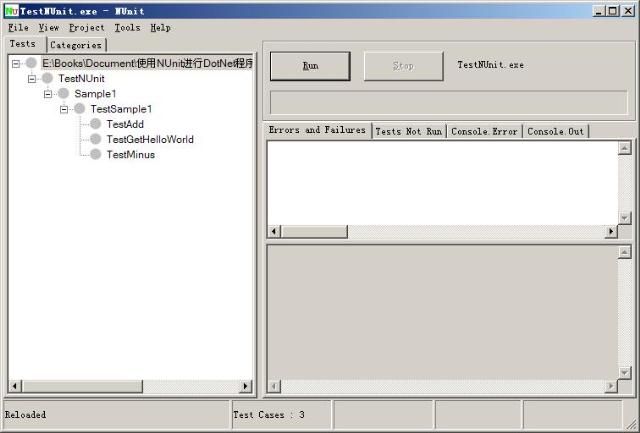
点击Run按钮,出现以下界面: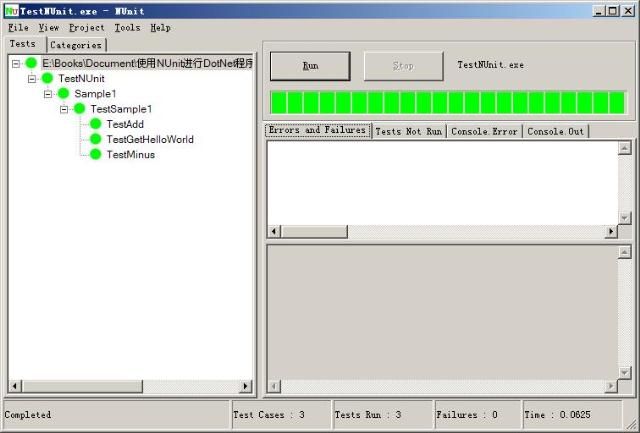
当运行栏全部是绿色的时候,表示写的测试全部通过,如果出现运行栏显示红色,表示测试出现问题,需要我们修改。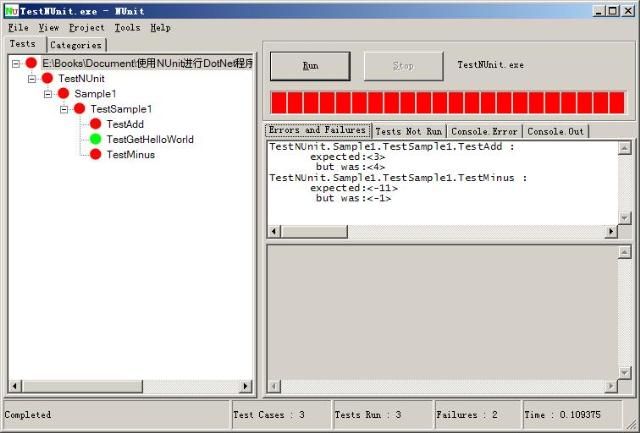
此时表示有两个方法(TestAdd,TestMinus)测试出现问题,需要我们去检查修改,然后重复以上的操作,直到运行栏全部不在显示红色为止。
Mock测试
简介
Mock测试就是在测试过程中,对于某个不容易构造或获取的对象,用一个虚假的对象来创建以方便测试的测试方法。
要使用Mock测试,需要有专门的Mock测试开发包支持,以下使用Nmock来说明。要获得Nmock可以从http://www.nmock.org/获得,目前使用NMock V1.1。
示例
添加引用
在项目中添加引用nmock.dll,可以从http://www.nmock.org/获得。
代码
需要被Mock的类:
| using System;
namespace TestNUnit.MockSample {
public class BigClass {
public virtual string DoSoming(string hello,string name,string symbol){
return "hello" + " " + name + symbol;
}
public virtual void DoNoing() {
//TODO
}
}
}
|
被测试的类:
| using System;
namespace TestNUnit.MockSample {
public class Sample {
private BigClass bc ;
public Sample(BigClass bc) {
this.bc = bc ;
}
public string GetHelloWorld() {
return "Hello World!";
}
public string GenerateHelloWorld(string hello,string name ,string symbol) {
return this.bc.DoSoming("Hello",name,symbol);
}
}
}
|
测试类:
| using System;
using NUnit.Framework;
using NMock ;
using NMock.Constraints;
namespace TestNUnit.MockSample {
[TestFixture]
public class TestMockSample {
private Mock mock ;
private Sample sample ;
[SetUp]
public void Init() {
this.mock = new DynamicMock(typeof(BigClass));
this.sample = new Sample((BigClass)mock.MockInstance);
}
[TearDown]
public void TearDown() {
mock.Verify();
}
[Test]
public void TestGetHelloWorld() {
this.mock.ExpectNoCall("DoSoming", typeof(String),typeof(String),typeof(String));
this.mock.ExpectNoCall("DoNoing");
Assert.IsNotNull(this.sample.GetHelloWorld());
Assert.AreEqual(this.sample.GetHelloWorld() ,"Hello World!" );
}
[Test]
public void TestGenerateHelloWorld() {
IsEqual hello = new IsEqual("Hello");
IsAnything name = new IsAnything();
IsEqual symbol = new IsEqual("!");
this.mock.ExpectAndReturn("DoSoming","Hello kongxx!" ,hello, name, symbol);
this.mock.ExpectNoCall("DoNoing");
Assert.AreEqual("Hello kongxx!",sample.GenerateHelloWorld("Hello","kongxx","!"));
}
}
}
|
运行
编译以上类,然后运行NUnit的图形界面,载入编译过的程序(exe或dll),出现以下界面: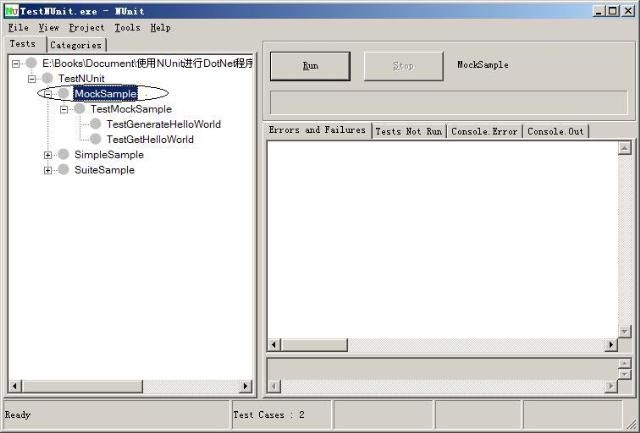
然后运行,出现以下界面: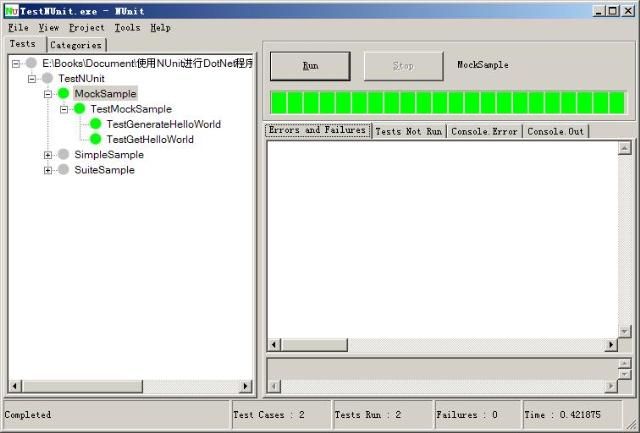
如果运行栏全部显示绿色表示通过测试,否则检查错误,修改,编译,运行直到全部运行成功为止。
参考资料
1NUnit http://www.nunit.org/
2Nmock http://www.nmock.org/index.html
3mockobjects http://www.mockobjects.com/FrontPage.html
Trackback: http://tb.blog.csdn.net/TrackBack.aspx?PostId=55742